|
A
couple years ago I scanned and posted just the plans for this Beechcraft
T-34 Mentor from the February 1974 American Aircraft Modeler
magazine. It is a fully aerobatic 60-size scale model. Finally,
I went back and scanned the article, too. It mentions availability
of a fiberglass cowl and a formed plastic canopy from Sig, but I
seriously doubt they are available today. Standard balsa and aircraft
plywood construction is used otherwise. Plans for this fine model
were drawn by Mr. Bud Adkinson, Jr., and Mr. H.G. Speer.
"The Beechcraft T-34 Mentor is a propeller-driven, single-engined,
military trainer aircraft derived from the Beechcraft Model 35 Bonanza."
-
Wikipedia
T-34B Mentor Plans
An accurate scale model of the T-34 advanced military trainer
still seen today on active duty. It is easy to fly yet stuntable.
Bud Atkinson
|
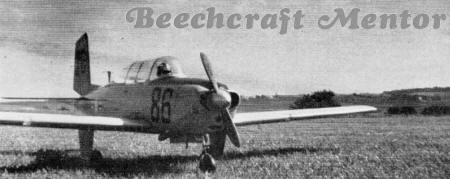
Beechcraft designed the Mentor as a high-speed prop-driven
trainer. The plane is fully aerobatic, including outside
maneuvers.
|
Scale builders are always on the lookout for good scale subjects;
ones that will adapt to model building and have good flying capabilities.
Many times an airplane that is ideal for RC scale is overlooked.
I think the T-34 has been, up to now, one of the overlooked. It's
easy to build and has very good flying capabilities, much the same
as our Class III stunt ship.
The Beechcraft model 45, named Mentor after the trusted servant
of Greek mythology, first flew as a prototype in late 1948. Since
that time the Mentor has served as a training airplane for thousands
of United States Air Force and Navy pilots and continues in
use at some military installations even today. Approximately 100
of the Wichita-built trainers are still in operation at the Pensacola
Naval Air Station.
The Mentor was designed and privately financed by Beechcraft
as a primary and basic trainer for the military services. It filled
the design requirements so well, that over 1000 units were produced
by Beechcraft for domestic and export sale. The aircraft was also
produced under license from Beech by Japanese, Canadian and Argentine
firms.
The Mentor, a single-engine, all-metal, two-place trainer, was
built around the then-new Beechcraft Bonanza design to assure high
performance while retaining economical operation and low fuel consumption.
|
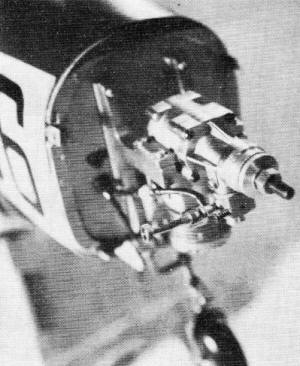
Under the fiberglass cowl (which is available from Ace
R/C Inc.), an Enya .60 on Midwest mounts and a Lakin nose-gear
assembly.
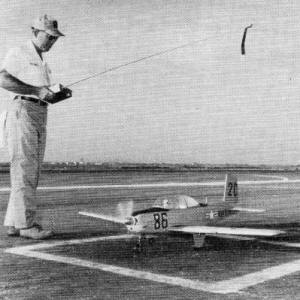
Following a realistic landing with the flaps down, Bud
taxies the Mentor into the "hangar" at the 1967 Nationals
at Los Angeles.
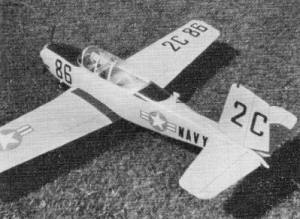
Because of its large flying. and control surface areas,
the model T-34 flies just as well, and is as aerobatic,
as the real plane.
|
The prototype aircraft was test flown December 2, 1948, by Vera
Carstens, now retired, who was then Beechcraft's chief test pilot.
The prototype Model 45 was powered by a Continental E-185 engine.
It had a cruise speed of 160 mph at 10,000 feet and a top speed
of 176 mph. Service ceiling was 18,000 feet and gross weight 2650
pounds.
The Mentor was stressed for ten positive and 4.5 negative "G's"
and was fully aerobatic - a feature demonstrated in exhibitions
at the Cleveland and Miami air races in 1949 and 1950 by the noted
aerobatic pilot Beverly E. "Bevo" Howard. Betty Skelton also flew
demonstration flights in the early Mentor. Additional demonstrations
were flown in the United States and overseas by Beechcraft and guest
military pilots through 1949 and 1950, winning every evaluation
competition entered.
First production model of the Mentor was delivered to the U.
S. Air Force, October 1953, at Edwards Air Force Base.
There it underwent evaluation in training conditions similar
to those it would encounter in actual use. At one time during the
evaluation, one Mentor was flown 23 hours and 20 minutes continuously
with only seven brief ground stops for refueling and crew change.
A total of 1904 Mentors were manufactured by Beechcraft from
December 1948 through 1958. These included 353 of the YT-34 and
T-34 models produced from March 1950 to October 1, 1956 for the
U. S. Air Force. The U. S. Navy version, the T-34B, was in production
from October 1954 to mid 1957 with 423 units delivered. Beech also
produced 318 units of the Model 45 for export.
Fuselage Construction: The T-34 fuselage is simple and straightforward,
much like any stunt ship, and since it has slab sides and bottom,
it makes for easy construction, not time consuming, as with many
scale airplanes that have round fuselage that require a lot of planking.
Only the top deck is planked on the T-34; if desired, the rear deck
can be installed in a one or two piece sheet. Also, the T-34 had
no wing fairing, like say, on a P-51 or Spitfire, which are rather
hard to build and fit properly. I used a fiberglass cowl, as I do
on all my scale airplanes, and is certainly worthwhile. However,
the cowl is large and could be made of wood. A glass cowl may be
obtained from Bee Line Products for $9.75.
Make sure the firewall is well epoxied onto the fuselage, as
the big mills have a lot of power. Also, the nose gear can, as we
all know, put a lot of strain on the firewall. I have to date, about
100 flights on my T-34 and the firewall shows no stress cracks.
Check plans carefully to see how the firewall is installed.
I do not show any servo mounting, as there are about five different
propo servos being used to date, so adapt servo mount to your particular
servos. The T-34 has lots of room, so there is no problem.
The T-34, as with many scale airplanes, loses much in appearance
if the proper canopy is not used. Most of the trainer-type airplanes
had rather large greenhouse type canopies, and to the average modeler,
this presents a problem. The canopy I used on my T-34 was made especially
for the T-34 by Sig. Glen told me he still has the mold pattern
for the T-34, and the canopy can be had upon request from Sig for
$2.75; very reasonable for a canopy that's almost 18 inches long
and 4 inches wide. The small bubble under the elevator is to house
the rudder horn that protrudes outside of the fuselage slightly,
so a small balsa fairing was used to cover the torque rod end and
rudder horn. So, it's out of scale! There's not much explanation
needed on the fuselage, as it is easy to construct.
Tail Construction: There are no problems here, as the fin and
rudder are standard, as is the stabilizer and elevators. Care should
be taken to select your wood; avoid hard, heavy balsa, as the tail
is large, especially the elevators and rudder, which are made of
solid sheet and should be of soft balsa. One of the pitfalls of
scale seems to be to come out tail-heavy. All fairing tail blocks
should be of soft balsa. Only the counter balance portion of the
elevators and rudder should be of hard balsa, with grain running
90 degrees to elevator and rudder grain. Do not silk elevators or
rudder; use tissue paper, so as not to warp.
Wing Construction: As you can see by the plans, the wing is constructed
about the same as any stunt wood wing would be. Landing gear installation
is standard. Epoxy gear block well as scale jobs are heavy and some
rougher landings are usually experienced. The airfoil used on the
T-34 is a basic 2412. I believe it to be one of the finest for scale.
The flaps are scale, and are rigged the same as you would strip
ailerons. I have found this to be much easier than the bellcrank
operated hook-up, as it's easier to make adjustment. A 1 1/16" wire
yoke may be used for hooking-up to servo.
A word on the flaps; it's a real thrill to use flaps on a scale
model, as it was on the prototype. There have been some misgivings
on the use of flaps in the past, but if they are properly installed
and wisely used they add much to your scale airplane. More on flaps
later.
A note of interest on the main gear doors: do not attach doors to
landing gear! I don't care how good a landing you make, the gear
doors will flex with the gear and dig into the wing, damaging the
wing skin. Glue or epoxy the doors to the wing itself with about
1/8 inch clearance from the gear leg. In this way the gear can flex
and not disturb the doors. I have flown my T-34 out of grass fields
and have made some rough landings with no damage to doors or wing.
The wing could be made of foam with no trouble, if so desired.
T-34A - T-34B: My model is the T-34B, or Navy version, and as
a trainer was all yellow-orange, with black lettering. Note the
V cut out of the lower section of the rudder. T-34A, as used by
the Air Force was basically the same, but was all natural aluminum,
with black letters. The T-34A did not have the V cut out on the
rudder. Don't ask me why. The Navy T-34 used only the OMNI antenna,
as plans show. You may find T-34's on about any Navy or Air Force
base today, and are a variety of colors from all white to wild red,
white and blue ones.
Flying Notes: I have built many scale RC airplanes, and many
barely made first flights that needed adjustments - shifting of
weight, etc., but the T-34 made almost perfect first test flights.
If I build a thousand scale models, I will still hate that first
flight; all that work and money, and loving care that goes into
a scale RC airplane, and there is always the possibility it will
go home in a basket. I hope they all fly as well as the T-34 did
in its maiden flight. The only adjustment to date was to the nose
gear for a straighter taxi.
Make your first flights with flaps up, to get your T-34 trimmed
and get the feel of the controls. I found it smooth, but yet responsive
on full command; the ailerons are very responsive for a scale, and
corrective rolls are easy to accomplish. I found, in fact, that
the T-34 will do any maneuver required in the stunt pattern. After
a couple of flights are made and she is trimmed to your satisfaction,
try flaps on takeoff. I have about 35 degrees full flap on my T-34;
you will notice the takeoff run somewhat shorter, and the climb
out steeper with flaps. Let it gain 50 or 60 feet of altitude, then
pull up the flaps; don't pull flaps too soon! As soon as the flaps
come up, the nose will drop back to level flight. Too soon or too
low flap retraction, and the T-34 will drop its nose to gain flying
speed and can be rather hairy if too low or slow. For landing, I
drop full flaps at about 40% power, or on my downwind leg of my
traffic pattern; you will notice the nose come up; trim with control
stick, not control trim, as you may have to make a go around or
apply full power, and you don't want downtrim. Anyway, I don't!
The nose will level as speed reduces. As you turn into the final,
slowly reduce power to about 20% (I like to fly them in myself).
You will notice that the T-34 will fly at this setting at almost
a perfect three-point attitude. As you are almost to the landing
spot, reduce the power to 10 or 15%, and as she touches the main
gear chop all power, and the Mentor will stick like on flypaper.
Power may be added in the final if too short with no ill effects,
- just don't let the nose get too high. Don't panic if you have
to make a go around with the flaps down; no harm is done, as you
can override the flaps with a slight bit of down elevator till you
feel you are at a safe altitude. I have tried dropping full flaps
at high speed and no adverse condition occurred. The nose came up
only to about 40 degrees in a big arc. It is not advisable to do
this as you could damage the servo or the flaps themselves.
I believe you will find, for a scale airplane that's 95% scale,
the T-34 Mentor flies and handles very well and is a joy to fly,
even on those no-contests Sundays. So let's build more scale!
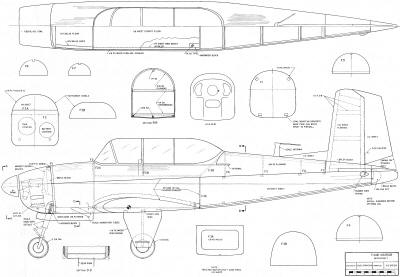
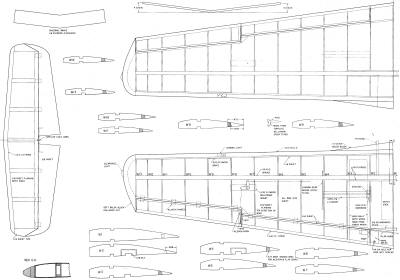
Notice:
The AMA Plans Service offers a
full-size version of many of the plans show here at a very reasonable cost. They
will scale the plans any size for you. It is always best to buy printed plans because
my scanner versions often have distortions that can cause parts to fit poorly. Purchasing
plans also help to support the operation of the
Academy of Model Aeronautics - the #1
advocate for model aviation throughout the world. If the AMA no longer has this
plan on file, I will be glad to send you my higher resolution version.
Try my Scale Calculator for
Model Airplane Plans.
Posted September 7, 2014
|